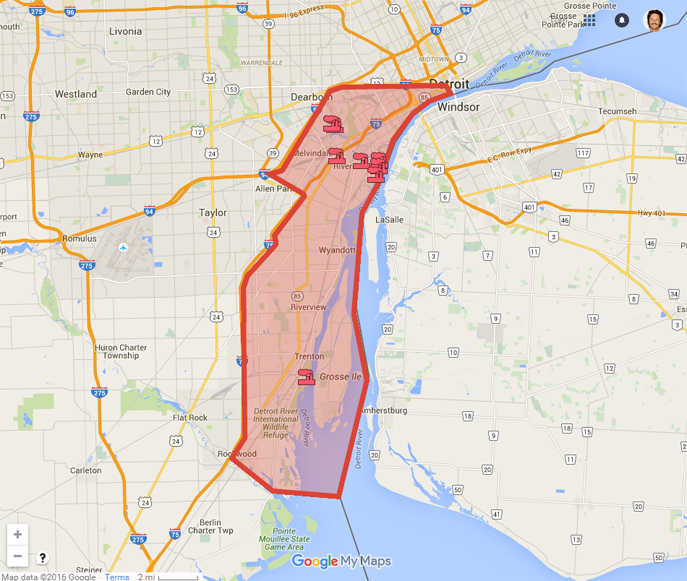Everything You Need to Know About the Sulfur Dioxide Air Pollution Crisis in Wayne County, Michigan
You may have heard the news: the Michigan Department of Environmental Quality (MDEQ) has proposed to allow a major Detroit-area polluter, Marathon Petroleum, to increase the emission of toxic and dangerous air pollutants. The zipcode in which the refinery is located is not only one of the poorest in the state[1] but is also already suffering disproportionately from bad air quality. In particular, a large swath of Wayne County has been designated as out of compliance with federal air quality standards for sulfur dioxide, a dangerous air pollutant that is linked to asthma and other respiratory problems.[2] At a public hearing held on January 6, around 500 residents[3] showed up to voice their anger that MDEQ appears poised to grant an increase in Marathon's air pollution at a time when MDEQ needs to be taking immediate steps to decrease the area's air pollution.
The proposed Marathon permit increase is just the latest blunder by the Snyder administration's MDEQ. Over the last few months, MDEQ has become embroiled in the Flint water crisis, in which an unknown number of children in Flint, Michigan, were exposed to dangerous levels of lead in their drinking water.[4] This travesty has led to the resignation of both MDEQ 's director and its spokesperson, forced the Michigan Governor to declare a state of emergency, and—most recently—drawn a federal investigation.
If anything good can come out of the tragic situation in Flint, it may be the heightened scrutiny of MDEQ 's actions (or rather, appalling inaction) in other poor, overburdened communities in Michigan. Like Wayne County. Wayne County is one of a handful of areas nationwide that the federal Environmental Protection Agency (EPA) has designated as out of compliance with federal sulfur dioxide air quality standards. The Wayne County "nonattainment area” (below) includes parts of Detroit and some downriver communities, such as River Rouge and Ecorse.[5]

[Click here to see sources of sulfur dioxide pollution]
Dangerous Health Impacts to Michigan 's Most Vulnerable Communities

Five-year-old La 'Miyah Hildreth wears a nebulizer in the kitchen of her grandmother Siobhan Washington. First published in the article The Cost of Coal, in the November/December 2012 Issue of Sierra magazine. Photo by Ami Vitale/Panos Pictures.
Sulfur dioxide pollution poses a serious threat to the health of those living in Detroit and downriver communities. Even short-term exposure (down to five minutes) of sulfur dioxide air pollution is linked to respiratory illness, particularly asthma.[6] Studies have connected short-term exposure to increased emergency room visits, particularly for children, the elderly, and asthmatics.[7] Sulfur dioxide also reacts in the atmosphere to form tiny particles that can deeply penetrate the lungs and cause respiratory disease and aggravate heart disease, leading to increased emergency room visits and even premature death.[8]
In 2008, the Michigan Department of Community Health ("MDCH”) coined Detroit "the epicenter of asthma burden in Michigan.”[9] MDCH found that the prevalence of asthma among adults in Detroit was 50 percent higher than the statewide average.[10] Likewise, rates of asthma hospitalization in Detroit (for both children and adults) were found to be three times higher than that of Michigan as a whole and rates of asthma death over two times higher compared to overall state numbers.[11]
Also alarmingly, a 2011 University of Michigan study found that schools located in areas with the highest air pollution levels had the lowest attendance rates and the highest proportions of students who failed to meet state educational testing standards.[12] The Detroit Alliance for Asthma Awareness lists asthma as the leading chronic condition causing school absenteeism in Detroit, as well as the leading cause of preventable hospitalizations for children under 18.[13]
Where's all this pollution coming from?
The brunt of the air pollution is emitted by several massive industrial sources, including U.S. Steel, EES Coke, Severstal, Marathon, and the DTE Energy Trenton Channel and River Rouge coal-fired power plants.[14]
The coal plants have the dubious honor of being responsible for 80 percent of the area 's sulfur dioxide emissions.[15] In 2012, for example, the River Rouge plant emitted over 8,200 tons of sulfur dioxide, while the Trenton Channel plant emitted over 22,400 tons.[16] For comparison, Marathon emitted around 137 tons that year.[17] The coal plants are so dirty because they lack modern pollution controls (or really, even non-modern pollution controls). For example, DTE's Monroe power plant—a coal plant located in Monroe County that has up-to-date controls—emitted 1,700 tons of sulfur dioxide for the first nine months of 2015, despite being capable of generating almost six times the electricity of the River Rouge facility.[18]
MDEQ: Head in the Sand Yet Again
The nonattainment designation triggers a series of legal requirements intended to bring air pollution levels back down to those safe for human health. Under federal law, MDEQ was required to submit a plan to the EPA by April 2015 that would curb sulfur dioxide pollution from the area 's largest polluters. MDEQ still hasn't done so. This past summer, MDEQ did issue a draft plan. In that draft, MDEQ proposed to do…pretty much nothing.
More specifically, MDEQ 's draft plan would require no pollution reductions and no new pollution controls at the Trenton Channel and River Rouge power plants, which emit the vast majority of the area 's asthma-inducing sulfur dioxide. In fact, under MDEQ's draft plan, those plants would actually be permitted to emit more sulfur dioxide per year than they have over each of the past few years.
To justify their so-called plan, MDEQ offered a series of excuses, each more offensive than the last. MDEQ admits that its plan doesn't comply with the law; its own air quality modeling showed that under its plan, significant exceedances of air quality standards would continue to occur over large parts of Wayne County.[19] But MDEQ claims that the sulfur dioxide problem is merely "theoretical.”[20] Once again, MDEQ would rather ignore data showing significant health impacts than take meaningful action.
And Now For Some Good News
The good news is, we know exactly what needs to be done. Pollution controls that can rein in the dumping of sulfur dioxide into Wayne County's air are readily available, and have been installed at power plants across the country. Thanks to extensive air quality modeling, we know exactly how each major facility's emissions should be limited to bring the area into compliance with federal law.[21]
We just need you to join us.
Add your voice to the hundreds demanding that MDEQ step up now and do its job: give us a plan that requires the needed controls at these polluting facilities. Send your congressperson an email, give them a phone call, tweet at the MDEQ or leave a message on their facebook page.
MDEQ can and should issue a comprehensive plan immediately. But the clock has run out, and under federal law, EPA can now step in and issue the plan itself. Tell EPA you support the immediate issuance of a federal plan that requires serious emissions reduction commitments.
And let us know you want to help by signing up for emails here—we 'll keep you up to speed on the latest developments and tell you about other ways you can pitch in.
The country is watching. Let's show them that we will not stand for the continued burdening of our poorest, most vulnerable communities with dangerous pollution.
[1] http://www.fox2detroit.com/news/local-news/70423180-story
[2] http://www3.epa.gov/airquality/sulfurdioxide/health.html
[3] http://www.fox2detroit.com/news/local-news/70423180-story
[4] For more on the Flint water crisis, see http://www.huffingtonpost.com/entry/flint-lead-poisoning_56732a38e4b06fa6887ca710
[5] http://www3.epa.gov/so2designations/tsd/05_MI_tsd.pdf. The area bounded on the east by the Michigan-Ontario border, on the south by the Wayne County-Monroe County border, on the west by Interstate 75 north to Southfield Road, Southfield Road to Interstate 94, and Interstate 94 north to Michigan Avenue, and on the north by Michigan Avenue to Woodward Avenue and a line on Woodward Avenue extended to the Michigan-Ontario border. See EPA, Air Quality Designations for the 2010 Sulfur Dioxide (SO2) Primary National Ambient Air Quality Standard, 78 Fed. Reg. 47,191-02, 47,201 (Aug. 5, 2013)
[6] http://www3.epa.gov/airquality/sulfurdioxide/health.html
[7] http://www3.epa.gov/airquality/sulfurdioxide/health.html
[8] http://www3.epa.gov/airquality/sulfurdioxide/health.html
[9] MDCH, Epidemiology of Asthma in Michigan 1 (2008) (emphasis added), available at http://www.michigan.gov/documents/mdch/epi-mich-asthma-Detroit_Epicenter_of_Asthma_401493_7.pdf.
[10] Id.
[11] Id.
[12] Mohai et al., Air Pollution Around Schools Is Linked To Poorer Student Health And Academic Performance, Health Affairs vol. 30, no. 5, 852-62 (May 2011) available at http://content.healthaffairs.org/content/30/5/852.full.pdf+html.
[13]Asthma Initiative of Michigan, Detroit Alliance for Asthma Awareness: Detroit Asthma Statistics, http://getasthmahelp.org/detroit-alliance-for-asthma-awareness.aspx (last visited Sept. 30, 2015).
[14] Draft MI NSIP—is it online?
[15] http://www3.epa.gov/so2designations/tsd/05_MI_tsd.pdf.at 5-6. The seven major emitting facilities within the State Recommended Nonattainment Area emit a total of 52,015 tons of SO2 per year. The River Rouge and Trenton Channel are responsible for 42,113 tons of SO2 emitted per year, or 80.96 percent of the total emissions. Combined, these two facilities produce more than six times the sulfur dioxide (in tons per year) than the next highest producing facility in the county. Id.
[16] MI draft NSIP
[17] MI draft NSIP
[18] River Rouge is a 540 MW facility; Monroe is over 3,000 MW. In 2012, before installing the controls, called "scrubbers” in utility lingo, the Monroe plant emitted over 25,000 tons of sulfur dioxide.
[19] MI draft NSIP.
[20] Jim Lynch, Michigan 's Tactics for Cutting Air Pollution Under Fire, The Detroit News (Mar. 10, 2015), available at http://www.detroitnews.com/story/news/local/michigan/2015/03/09/michigans-tactics-cutting-air-pollution- fire/24683209/
[21] Reference the detailed comments and expert analysis submitted by the Sierra Club in response to MDEQ 's draft plan.